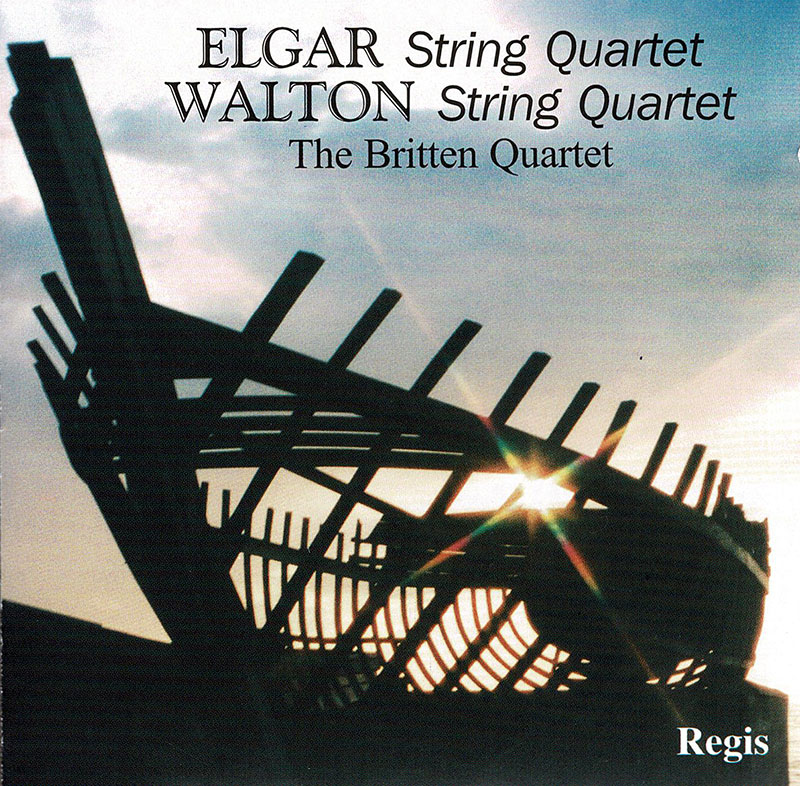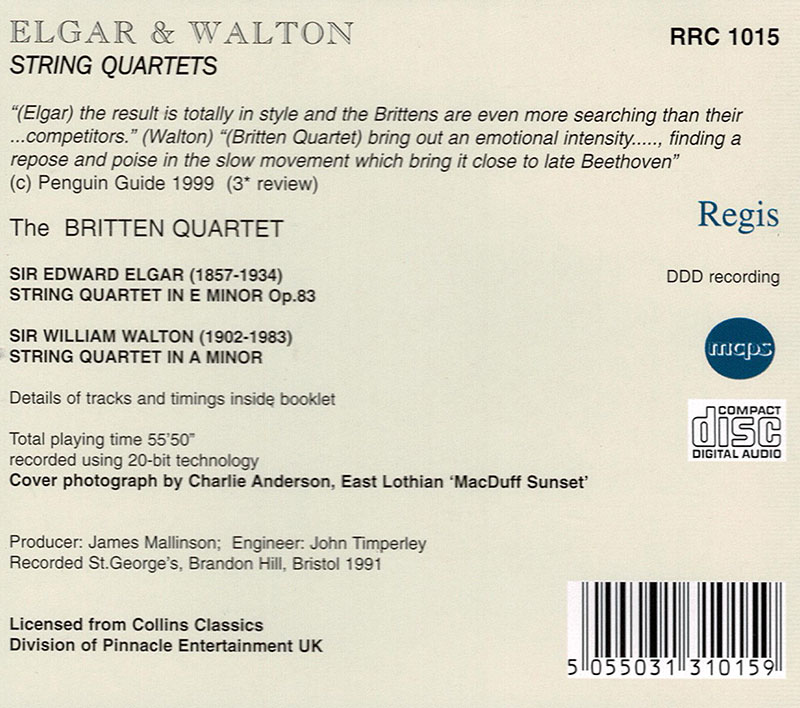Logowanie
Mikołaj - ten to ma gest!
Miles Davis, Horace Silver, Jay Jay Johnson, Percy Heath, Kenny Clarke, Lucky Thompson
Walkin'
20bit K2Super Coding - ale jak to brzmi!
Kasety magnetofonowe
Winylowy niezbędnik
ClearAudio
Double Matrix Professional - Sonic
najbardziej inteligentna i skuteczna pralka do płyt winylowych wszelkiego typu - całkowicie automatyczna
ELGAR, WALTON, The Britten Quartett
String Quartets

- Sir Edward Elgar: String Quartet in E Minor op.83
- 1. 1. Allegro moderato 10.00
- 2. 11. Piacevole (poco andante) 10.01
- 3. III. Finale: Allegro molto 8.05
- Sir William Walton: String Quartet
- 4.1. Allegro 9.59
- 5.11. Presto 3.50
- 6.III, Lento 8.47
- 7. IV. Allegro molto 4.35
- The Britten Quartett
- ELGAR
- WALTON
"totally in style and even more searching than their competitors" "bitingly powerful... emotional intensity... repose and poise... which brings it close to late Beethoven" (Penguin Guide 3*) Sir Edward Elgar began composing his String Quartet in E minor opus 83 on 25th March 1918 when he was convalescing following the painful removal of a tonsil as part of an effort to reduce giddiness experienced on and off since 1912. This had not been Elgar's (1857-1934) first attempt to write for string quartet: some fragments exist from the 1880s and in 1907 he sketched another work which was left incomplete. Elgar's illness and anxiety about the War (the Russians having signed a peace treaty with Germany which effectively enabled the Germans to conduct a huge offensive on the Western Front) conspired to make its first movement almost unparalleled in Elgar's work for sparsity and lack of expressive and noble melody. Unable for the moment to complete the Quartet Elgar broke off to write a Violin Sonata. Once this Sonata was out of the way and with more encouraging war news at hand, Elgar returned to the String Quartet in October 1918, working on it concurrently with another chamber piece, the melodious Piano Quintet. On the eve of her seventieth birthday Alice, the composer's wife, who was herself unwell, described the Quartet's second movement marked Piacevole as 'so gracious and lovable'. Later still she wrote of how this same movement reminded her of 'captured sunshine' and Troyte Griffith remarked to the composer that it was 'as fine as a quartet by Beethoven'. This second movement was completed on 26th November 1918. The War now being over, Elgar proceeded at a faster rate and the Quartet was concluded that Christmas Eve , its third and final movement being 'very impassioned and carrying one along at a terrific rate' (Alice Elgar in a diary note on 8th December). It was dedicated to the Brodsky Quartet, to whom Elgar had promised a work since the beginning of the century. The second movement had clearly been one of Alice Elgar's pieces and it was played at her funeral (10th April 1920) by a distinguished group of players - Sammons, Tertis, Salmond, and WH Reed. Its appropriateness to the occasion was much appreciated by the composer in a letter to Frank Schuster, who, together with Elgar's daughter Carice, had organised the playing of this piece at the funeral: 'It was exactly right and just what she would have wished'. . All three chamber works - the Violin Sonata, the Piano Quintet and the String Quartet-were given a 'preview' performance on 26th April 1919, with the premiere proper being played a month later at the Wigmore Hall in London. Critics on the whole were puzzled by the abrasive nature of the String Quartet with its comparative lack of melodiousness and noble lines that had distinguished Elgar's work in the past. The Cello Concerto (1919), in which the solo instrument picks its way carefully through the upper and lower extremities of the orchestra before settling into the retrospective longing of the Adagio movement, still further captures the mind of a sad and lonely composer uncertain of his direction in a new musical and political world. Sir William Walton (1902-1983) wrote two quartets: the first was first performed 4th March 1921 and was partially rewritten two years later with an additional third movement. Described as 'horrible' and neither 'serious' nor 'music' by the eminent critic Ernest Newman it was much later disowned by the composer who added to Newman's description of it saying it was 'horrible with bits of Schoenberg, Berg and Heaven knows what else'. When the McCulloch Quartet played the new version at the Royal College of Music on 5 July 1923 another critic asked 'Am I music-mad or is this man?' He felt that the young composer was too concerned with looking forward and 'seemed to be trying to repress his natural instincts to be melodious'. In August 1923 the McCulloch Quartet played the work at the Salzburg ISCM Festival where it was claimed that Walton's Quartet was not representative of the best of British music. A clearly restless audience became convulsed with laughter when the cellist accidentally put her spike onto the trap door mechanism and slowly sunk out of sight, eventually coming up apparently unperturbed and smiling like a pantomime fairy! This first Quartet was clearly an unhappy experience for the young composer; however from it two useful friendships developed with Alban Berg and Hindemith both of whom he met at the concert. His friendship with Hindemith, an excellent violist, bore fruit several years later when Hindemith agreed to premiere Walton's Viola Concerto, it having been refused by Lionel Tertis. Walton began composing his String Quartet in A minor during the summer of 1945 and dedicated it to Ernest Irving , a conductor who had helped him with a number of his wartime film scores and was first performed on the BBC by the Blech Quartet 4th May 1947. The first public performance occurred the following day at the Concert Hall of Broadcasting House, again with the Blech Quartet. Neil Tierney describes the Quartet as a 'full-blooded composition, distinguished by Walton's characteristic nostalgia and pugnacity, as well as some of the mellowest music he had ever written ... creates a feeling of tension and purpose' (William Walton - His Life and Music p242). The opening movement Allegro is the longest and most elaborate of the four with a flowing theme for viola set against a counter-theme for second violin. The viola theme is transformed into a fugue which builds to a climax that then dies down to a gentle coda. The second movement marked Presto in 3/8 time is a short and witty fairy dance, whilst the third movement Lento uses the viola to good effect. Its solo introduces a romantic theme that is discussed freely but tenderly between the instruments. The short finale Allegro molto is more rhythmic, putting an end to the dreamlike sentiments of the preceding movement. Although not devoid of lyricism this brings the work to an exciting conclusion. In 1971 Walton, with the assistance of Malcolm Arnold, orchestrated the Quartet at the request of Neville Marriner, with slight changes being made to the structure of the first movement. This was published as Sonata for string orchestra and first performed by the Academy of St Martin-in-the-Fields under Marriner in Perth, Western Australia in March 1972. Its British premiere was during the Bath Festival that May.






























